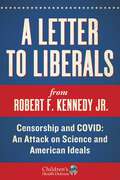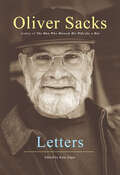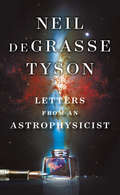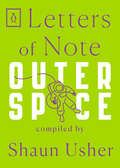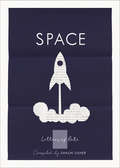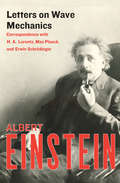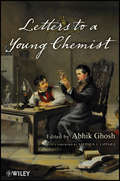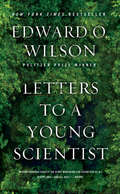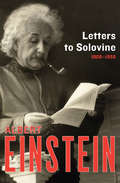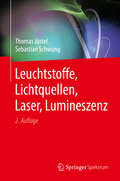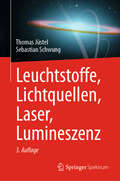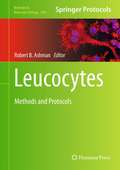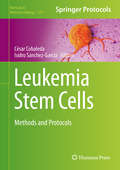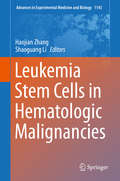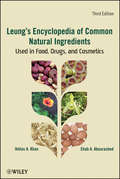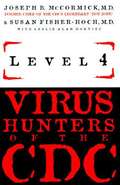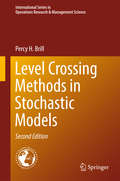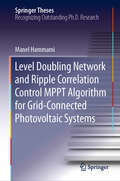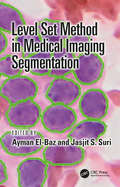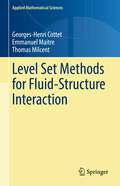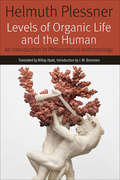- Table View
- List View
Let's Visit A Space Camp
by Edith AlstonTours the Space and Rocket Center in Huntsville, Alabama, describing exhibits, spacecrafts, and activities at the space camp where children can experience what space travel feels like and participate in a simulated space shuttle mission
A Letter to Liberals: Censorship and COVID: An Attack on Science and American Ideals (Children’s Health Defense)
by Robert F. Kennedy Jr.A leading Democrat challenges his party to return to liberal values and evidence-based science Democrats were the party of intellectual curiosity, critical thinking, and faith in scientific and liberal empiricism. They once took pride in understanding how to read science critically, exercising healthy skepticism toward notoriously corrupt entities like the drug companies that brought us the opioid crisis, and were outraged by the phenomenon of &“agency capture&” and the pervasive control of private interests over Congress, the media, and the scientific journals. During the COVID pandemic, these attitudes have taken a back seat to blind faith in government mandates and countermeasures driven by pharmaceutical companies and captive federal agencies, promoted by corporate media, and cynically exploiting the fears of the American people. A Letter to Liberals is Robert F. Kennedy Jr.&’s, challenge to &“lockdown liberalism&’s&” embrace of policies that are an affront to once cherished precepts. Kennedy invites readers to look at the data in order to answer questions such as:Did COVID vaccines really save millions and end the pandemic?Why were the lowest COVID death rates in countries and states that relied on therapeutic drugs, and in countries with the lowest vaccination rates?Did vaccines prevent infection or transmission as officials promised?Why do COVID vaccines appear to show &“negative efficacy&”—making the vaccinated more susceptible to COVID.Why does the most reliable data suggest that COVID vaccines do not lower the risk of death and hospitalization.Should government technocrats be partnering with media and social media titans to censor and suppress the questioning of government policies?And why have so many liberals abandoned fundamental Constitutional principles in their headlong rush to embrace pandemic policies pushed by captured bureaucrats, feckless politicians, a compromised news media, and Big Pharma?In his November 2021 book The Real Anthony Fauci, which sold over 1,000,000 copies, Kennedy made predictions that have matured from &“conspiracy theories&” to proven facts. Among these: Masks Are Ineffective and DangerousSocial Distancing Was Not Science-BasedSchool Closures Were Not Science-BasedLockdowns Were CounterproductiveVaccinating Children Causes More Harm and Death Than It AvertsOfficials Wrongly Used PCR Tests to Justify the CountermeasuresCOVID-19 May Have Come from Wuhan LabNatural Immunity is Superior to Vaccine Immunity Kennedy throws down the gauntlet for the kind of vigorous scientific debate that liberals have long stood for and strives to ensure that unbiased honesty and well-researched thought is brought to bear on one of the most important and still unfolding chapters in human history.
Letters
by Oliver SacksThe letters of one of the greatest observers of the human species, revealing his passion for life and work, friendship and art, medicine and society, and the richness of his relationships with friends, family, and fellow intellectuals over the decades, collected here for the first time&“Here is the unedited Oliver Sacks—struggling, passionate, a furiously intelligent misfit. And also endless interesting. He was a man like no other.&” —Atul Gawande, author of Being MortalDr. Oliver Sacks—who describes himself in these pages as a &“philosophical physician&” and a &“neuropathological Talmudist&”—wrote letters throughout his life: to his parents and his beloved Auntie Len, to friends and colleagues from London, Oxford, California, and around the world. The letters begin with his arrival in America as a young man, eager to establish himself away from the confines of postwar England, and carry us through his bumpy early career in medicine and the discovery of his writer&’s voice; his weight-lifting, motorcycle-riding years and his explosive seasons of discovery with the patients who populate his book Awakenings; his growing interest in matters of sight and the musical brain; his many friendships and exchanges with writers, artists, and scientists (to say nothing of astronauts, botanists, and mathematicians), and his deep gratitude for all these relationships at the end of his life.Sensitively introduced and edited by Kate Edgar, Sacks&’s longtime editor, the letters deliver a portrait of Sacks as he wrestles with the workings of the brain and mind. We see, through his eyes, the beginnings of modern neuroscience, following the thought processes of one of the great intellectuals of our time, whose words, as evidenced in these pages, were unfailingly shaped with generosity and wonder toward other people.
Letters
by Oliver SacksThe letters of one of the greatest observers of the human species, revealing his passion for life and work, friendship and art, medicine and society, and the richness of his relationships with friends, family, and fellow intellectuals over the decades, collected here for the first time &“Here is the unedited Oliver Sacks—struggling, passionate, a furiously intelligent misfit. And also endless interesting. He was a man like no other.&” —Atul Gawande, author of Being MortalDr. Oliver Sacks—who describes himself in these pages as a &“philosophical physician&” and a &“neuropathological Talmudist&”—wrote letters throughout his life: to his parents and his beloved Auntie Len, to friends and colleagues from London, Oxford, California, and around the world. The letters begin with his arrival in America as a young man, eager to establish himself away from the confines of postwar England, and carry us through his bumpy early career in medicine and the discovery of his writer&’s voice; his weight-lifting, motorcycle-riding years and his explosive seasons of discovery with the patients who populate his book Awakenings; his growing interest in matters of sight and the musical brain; his many friendships and exchanges with writers, artists, and scientists (to say nothing of astronauts, botanists, and mathematicians), and his deep gratitude for all these relationships at the end of his life.Sensitively introduced and edited by Kate Edgar, Sacks&’s longtime editor, the letters deliver a portrait of Sacks as he wrestles with the workings of the brain and mind. We see, through his eyes, the beginnings of modern neuroscience, following the thought processes of one of the great intellectuals of our time, whose words, as evidenced in these pages, were unfailingly shaped with generosity and wonder toward other people.
Letters from an Astrophysicist
by Neil DeGrasse TysonA luminous companion to the phenomenal bestseller Astrophysics for People in a Hurry. <P><P>Astrophysicist Neil deGrasse Tyson has attracted one of the world’s largest online followings with his fascinating, widely accessible insights into science and our universe. Now, Tyson invites us to go behind the scenes of his public fame by revealing his correspondence with people across the globe who have sought him out in search of answers. In this hand-picked collection of 101 letters, Tyson draws upon cosmic perspectives to address a vast array of questions about science, faith, philosophy, life, and of course, Pluto. His succinct, opinionated, passionate, and often funny responses reflect his popularity and standing as a leading educator. <P><P>Tyson’s 2017 bestseller Astrophysics for People in a Hurry offered more than one million readers an insightful and accessible understanding of the universe. Tyson’s most candid and heartfelt writing yet, Letters from an Astrophysicist introduces us to a newly personal dimension of Tyson’s quest to explore our place in the cosmos. <P><P><b>A New York Times Bestseller</b>
Letters of Note: Outer Space (Letters of Note #11)
by Shaun UsherAn irresistible new volume of missives about outer space, from the author of the bestselling Letters of Note collectionsIn Letters of Note: Outer Space, Shaun Usher brings together fascinating correspondence about the universe beyond our planet, containing hopeful thoughts about the future of space travel, awestruck messages penned about the world beyond our own and celebrations of the human ingenuity that has facilitated our understanding of the cosmos.Includes letters by:Buzz Aldrin, Isaac Asimov,Marion Carpenter, Yuri Gagarin,Ann Druyan, Stanley Kubrick,Nikola Tesla, Neil DeGrasse Tyson& many more
Letters of Note: Space (Letters of Note #11)
by Shaun UsherAn awe-inspiring collection of letters on the subject of outer space curated by the founder of the phenomenally popular Letters of Note website. The first volume in the bestselling Letters of Note series was a collection of hundreds of the world's most entertaining, inspiring, and unusual letters, based on the seismically popular website of the same name--an online museum of correspondence visited by over 70 million people. From Virginia Woolf's heartbreaking suicide letter, to Queen Elizabeth II's recipe for drop scones sent to President Eisenhower; from the first recorded use of the expression 'OMG' in a letter to Winston Churchill, to Gandhi's appeal for calm to Hitler; and from Iggy Pop's beautiful letter of advice to a troubled young fan, to Leonardo da Vinci's remarkable job application letter. Now, the curator of Letters of Note, Shaun Usher, gives us wonderful new volumes featuring letters organized around a universal theme. In this volume, Shaun Usher turns to the subject of outer space and space travel. Includes letters by Buzz Aldrin, Isaac Asimov, Marion Carpenter, Yuri Gagarin, Ann Druyan, Stanley Kubrick, Alexander Graham Bell, Neil DeGrasse Tyson and many more.
Letters on Wave Mechanics: Correspondence with H. A. Lorentz, Max Planck, and Erwin Schrödinger
by Albert EinsteinA lively collection of Einstein&’s groundbreaking scientific correspondence on modern physics Imagine getting four of the greatest minds of modern physics in a room together to explain and debate the theories and innovations of their day. This is the fascinating experience of reading Letters on Wave Mechanics, the correspondence between H. A. Lorentz, Max Planck, Erwin Schrödinger, and Albert Einstein. These remarkable letters illuminate not only the basis of Schrödinger&’s work in wave mechanics, but also how great scientific minds debated and challenged the ever-changing theories of the day and ultimately embraced an elegant solution to the riddles of quantum theory. Their collected correspondence offers insight into both the personalities and professional aspirations that played a part in this theoretical breakthrough. This authorized ebook features rare photos and never-before-seen documents from the Albert Einstein Archives at the Hebrew University of Jerusalem.
Letters on Wave Mechanics: Correspondence with H. A. Lorentz, Max Planck, and Erwin Schrödinger (Paperback Ser.)
by Albert EinsteinA lively collection of Einstein&’s groundbreaking scientific correspondence on modern physics Imagine getting four of the greatest minds of modern physics in a room together to explain and debate the theories and innovations of their day. This is the fascinating experience of reading Letters on Wave Mechanics, the correspondence between H. A. Lorentz, Max Planck, Erwin Schrödinger, and Albert Einstein. These remarkable letters illuminate not only the basis of Schrödinger&’s work in wave mechanics, but also how great scientific minds debated and challenged the ever-changing theories of the day and ultimately embraced an elegant solution to the riddles of quantum theory. Their collected correspondence offers insight into both the personalities and professional aspirations that played a part in this theoretical breakthrough. This authorized ebook features rare photos and never-before-seen documents from the Albert Einstein Archives at the Hebrew University of Jerusalem.
Letters to a Young Chemist
by Abhik Ghosh Stephen J. LippardWhat's it really like to be a chemist?Leading chemists share what they do, how they do it, and why they love it."Letters to a young ..." has been a much-loved way for professionals in a field to convey their enthusiasm and the realities of what they do to the next generation. Now, Letters to a Young Chemist does the same for the chemical sciences. Written with a humorous touch by some of today's leading chemists, this book presents missives to "Angela," a fictional undergraduate considering a career in chemistry. The different chapters offer a mix of fundamental principles, contemporary issues, and challenges for the future. Marye Anne Fox, Chancellor of the University of California San Diego, talks about learning to do research and modern physical organic chemistry. Brothers Jonathan and Daniel Sessler explain the chemistry of anesthetics that make modern surgery possible while Elizabeth Nolan talks about biological imaging. Terry Collins talks about green chemistry, a more sustainable way of doing chemistry, while several authors including Carl Wamser, Harry Gray, John Magyar, and Penny Brothers discuss the crucial contributions that chemists can make in meeting global energy needs.Letters to a Young Chemist gives students and professionals alike a unique window into the real world of chemistry. Entertaining, informative, and full of honest and inspiring advice, it serves as a helpful guide throughout your education and career."The different chapters describe both the wonders of the molecular world and the practical benefits afforded by chemistry ... and if any girl out there thinks that chemistry is a man's world, this book should be a good antidote." --Marye Anne Fox, Chancellor of the University of California, San Diego, and winner of the 2009 US National Medal of Science"Letters to a Young Chemist offers significant ammunition for motivating young people to consider chemistry as a career. ... This book should also be required reading for all faculty members who teach chemistry in high schools, colleges, and universities." --Stephen J. Lippard, Arthur Amos Noyes Professor of Chemistry, Massachusetts Institute of Technology, and winner of the 2006 US National Medal of Science
Letters to a Young Scientist
by Edward O. WilsonPulitzer Prize-winning biologist Edward O. Wilson imparts the wisdom of his storied career to the next generation. Edward O. Wilson has distilled sixty years of teaching into a book for students, young and old. Reflecting on his coming-of-age in the South as a Boy Scout and a lover of ants and butterflies, Wilson threads these twenty-one letters, each richly illustrated, with autobiographical anecdotes that illuminate his career--both his successes and his failures--and his motivations for becoming a biologist. At a time in human history when our survival is more than ever linked to our understanding of science, Wilson insists that success in the sciences does not depend on mathematical skill, but rather a passion for finding a problem and solving it. From the collapse of stars to the exploration of rain forests and the oceans' depths, Wilson instills a love of the innate creativity of science and a respect for the human being's modest place in the planet's ecosystem in his readers.
Letters to Solovine, 1906–1955
by Albert EinsteinA provocative collection of letters to his longtime friend and translator that spans Einstein&’s career and reveals the inner thoughts and daily life of a transformative geniusFrom their early days as tutor and scholar discussing philosophy over Spartan dinners to their work together to publish Einstein&’s books in Europe, in Maurice Solovine, Albert Einstein found both an engaged mind and a loyal friend. While Einstein frequently shared his observations on science, politics, philosophy, and religion in his correspondence with Solovine, he was just as likely to express his feelings about everyday life—his health and the effects of aging and his experiences in the various places where he settled and visited in his long career. The letters are both funny and frank, and taken together, reflect the changes—large and small—that took place over a half century and in the remarkable life of the world&’s foremost scientist. Published in English alongside the German text and accompanied by facsimile copies of the original letters, the collected Letters to Solovine offers scholar and interested reader alike unprecedented access to the personal life of Albert Einstein. This authorized ebook features a new introduction by Neil Berger, PhD, and an illustrated biography of Albert Einstein, which includes rare photos and never-before-seen documents from the Albert Einstein Archives at the Hebrew University of Jerusalem.
Letters to Solovine, 1906–1955: 1906–1955 (Paperback Ser.)
by Albert EinsteinA provocative collection of letters to his longtime friend and translator that spans Einstein&’s career and reveals the inner thoughts and daily life of a transformative geniusFrom their early days as tutor and scholar discussing philosophy over Spartan dinners to their work together to publish Einstein&’s books in Europe, in Maurice Solovine, Albert Einstein found both an engaged mind and a loyal friend. While Einstein frequently shared his observations on science, politics, philosophy, and religion in his correspondence with Solovine, he was just as likely to express his feelings about everyday life—his health and the effects of aging and his experiences in the various places where he settled and visited in his long career. The letters are both funny and frank, and taken together, reflect the changes—large and small—that took place over a half century and in the remarkable life of the world&’s foremost scientist. Published in English alongside the German text and accompanied by facsimile copies of the original letters, the collected Letters to Solovine offers scholar and interested reader alike unprecedented access to the personal life of Albert Einstein. This authorized ebook features a new introduction by Neil Berger, PhD, and an illustrated biography of Albert Einstein, which includes rare photos and never-before-seen documents from the Albert Einstein Archives at the Hebrew University of Jerusalem.
Leuchtstoffe, Lichtquellen, Laser, Lumineszenz
by Thomas Jüstel Sebastian SchwungDas vorliegende Buch dient als Nachschlagewerk wichtiger Begriffe und Materialien, die im Bereich der Lumineszenz sowie der Lampen-, Laser-, Leuchtstoff- und Lichttechnik von Bedeutung sind. Es liefert somit Antworten und Daten zu Fragestellungen im Zusammenhang mit dem Fachgebiet der Photonik.
Leuchtstoffe, Lichtquellen, Laser, Lumineszenz
by Thomas Jüstel Sebastian SchwungDieses Buch dient als Nachschlagewerk für wichtige Begriffe und Materialien im Bereich der Lumineszenz sowie der Lampen-, Laser-, Phosphor- und Beleuchtungstechnik. Es handelt sich um eine Art Wörterbuch, das Antworten und Daten zu Fragen aus dem spezialisierten Bereich der Photonik bietet. Die dritte Auflage des Buches bietet einen erweiterten und aktualisierten Überblick über die wichtigsten Begriffe und Größen in der Photonik. Es richtet sich sowohl an Fachleute als auch an Studierende, die eine umfassende und verlässliche Quelle für ihre wissenschaftlichen Arbeiten und praktischen Anwendungen suchen.
Leucocytes
by Robert B. AshmanThe innate immune response is a crucial component of early resistance to infection, and it is now revealing increasing levels of complexity. The ability to modify the genome in vivo, has facilitated understanding of complex interactions between leucocytes and other components of the immune system, and phenotype-driven strategies using chemical mutagenesis have placed another powerful weapon in the armamentarium. In, Leucocytes: Methods and Protocols provides detailed protocols and practical advice on a variety of modern approaches to the study of leucocytes and their products. Written in the highly successful Methods in Molecular BiologyTM series format, chapters include introductions to their respective topics, lists of the necessary materials and reagents, step-by-step, readily reproducible laboratory protocols, and key tips on troubleshooting and avoiding known pitfalls. Authoritative and practical, Leucocytes: Methods and Protocols seeks to aid scientists in further study into the immune system and leucocytes.
Leukemia Stem Cells: Methods and Protocols (Methods in Molecular Biology #2185)
by César Cobaleda Isidro Sánchez-GarcíaThe detailed volume aims to provide a comprehensive hands-on manual covering all the techniques involved in the cellular and molecular identification and characterization of both normal hematopoietic and leukemic stem cells, both from human patients and from mouse models of human leukemia. The book also covers the most frequently used experimental approaches for the generation of such stem cell-based models of human leukemia. Written for the highly successful Methods in Molecular Biology series, chapters include introductions to their respective topics, lists of the necessary materials and reagents, step-by-step, readily reproducible laboratory protocols, and tips on troubleshooting and avoiding known pitfalls. Authoritative and comprehensive, Leukemia Stem Cells: Methods and Protocols serves as an ideal guide for researchers, both expert and novice, seeking to further our knowledge of this vital avenue of cancer research.
Leukemia Stem Cells in Hematologic Malignancies (Advances in Experimental Medicine and Biology #1143)
by Haojian Zhang Shaoguang LiThis book introduces readers to the biology of leukemia stem cells (LSCs) and emphasizes the necessity and importance of targeting LSCs in the treatment of hematopoietic malignancies. It addresses the role of leukemia stem cells in different leukemia diseases and molecular signatures, as well as the metabolic and epigenetic regulation of leukemia stem cell function. With regard to solid tumors, a significant number of blood cancers are believed to be derived from leukemia stem cells (LSCs), which are responsible for disease progression, relapse and drug resistance. Consequently, new therapeutic strategies need to be developed by focusing on the complete eradication of LSCs. Given its scope, the book offers a valuable asset for graduate students and scientists in the fields of cell biology and cancer research etc.
Leung's Encyclopedia of Common Natural Ingredients
by Ikhlas A. Khan Ehab A. AbourashedThe third edition of the unparalleled reference on natural ingredients and their commercial useThis new Third Edition of Leung's Encyclopedia of Common Natural Ingredients: Used in Food, Drugs, and Cosmetics arrives in the wake of the huge wave of interest in dietary supplements and herbal medicine resulting from both trends in health and the Dietary Supplement and Health Education Act of 1994 (DSHEA). This fully updated and revised text includes the most recent research findings on a wide variety of ingredients, giving readers a single source for understanding and working with natural ingredients.The Encyclopedia continues the successful format for entries listed in earlier editions (consisting of source, description, chemical composition, pharmacology, uses, commercial preparations, regulatory status, and references). The text also features an easily accessible alphabetical presentation of the entries according to common names, with the index cross-referencing entries according to scientific names.This Third Edition also features:More than 50 percent more information than the Second Edition, reflecting the greatly increased research activity in recent yearsA new section on traditional Indian medicine, with information on nine commonly used herbsMore than 6,500 referencesTwo new appendices explaining and illustrating the botanical terminology frequently encountered in the textA revised and expanded indexLeung's Encyclopedia of Common Natural Ingredients: Used in Food, Drugs, and Cosmetics, Third Edition will continue to provide a comprehensive compilation of the existing literature and prominent findings on natural ingredients to readers with an interest in medicine, nutrition, and cosmetics.
Level 4: Virus Hunters of the CDC
by Joseph Mccormick Leslie A. Horvitz Susan Fisher-Hoch"Sublimely equipped to survive, to propagate, to conquer, the virus is neither really alive nor really dead. Its dimensions are measured in molecules. It attacks by dismantling its human targets cell by cell." "Level 4: Virus Hunters of the CDC is an intense, personal account of more than a quarter-century on the front lines - in the ultra high-tech "hot zone" lab that McCormick was instrumental in creating at the Centers for Disease Control headquarters in Atlanta, as well as in the most primitive places on the planet, where the local climate, terrain, and politics can kill just as surely as any disease." "Told in intimate detail by two of the world's best-known virologists - colleagues, collaborators, husband and wife - Level 4 is a journey across the world and into many strange new worlds: from the seductive beauty of equatorial Africa - a limitless reservoir of infection - to the confines of the all-but-invisible field of the electron microscope. While other books have offered hot zones, sick monkeys, and grim statistics, Level 4 brings home from the world of the virus the human stories of those who lived, and those who died."--BOOK JACKET. Title Summary field provided by Blackwell North America, Inc. All Rights Reserved
Level Crossing Methods in Stochastic Models
by Percy H. BrillFrom 1972 to 1974, I was working on a PhD thesis entitled Multiple Server Queues with Service Time Depending on Waiting Time. The method of analysis was the embedded Markov chain technique, described in the papers [82] and [77]. My analysis involved lengthy, tedious deri- tions of systems of integral equations for the probability density function (pdf) of the waiting time. After pondering for many months whether there might be a faster, easier way to derive the integral equations, I ?nally discovered the basic theorems for such a method in August, 1974. The theorems establish a connection between sample-path level-crossing rates of the virtual wait process and the pdf of the waiting time. This connection was not found anywhere else in the literature at the time. I immediately developed a comprehensive new methodology for deriving the integral equations based on these theorems, and called it system point theory. (Subsequently it was called system point method,or system point level crossing method: SPLC or simply LC. ) I rewrote the entire PhD thesis from November 1974 to March 1975, using LC to reach solutions. The new thesis was called System Point Theory in Exponential Queues. On June 12, 1975 I presented an invited talk on the new methodology at the Fifth Conference on Stochastic Processes and their Applications at the University of Maryland. Many queueing theorists were present.
Level Doubling Network and Ripple Correlation Control MPPT Algorithm for Grid-Connected Photovoltaic Systems (Springer Theses)
by Manel HammamiThis book describes an original improvement in power quality of photovoltaic generation systems obtained by the use of a multilevel inverter implemented with level doubling network (LDN). Modulation principles and harmonic analysis of output voltages are proposed and introduced in detail for both single and three-phase LDN configurations. The analysis is then extended to dc-link current and voltage, with emphasis to low-frequency harmonics and switching frequency ripple. This work represents the first comprehensive implementation of maximum power point tracking (MPPT) schemes using the ripple correlation control (RCC) algorithm in the presence of multiple ripple harmonics, such as in the case of multilevel inverters. Numerical simulations and experimental tests are carefully reported here, together with practical insights into the design of dc-link capacitors.
Level Set Method in Medical Imaging Segmentation
by Ayman El-Baz Jasjit S. SuriLevel set methods are numerical techniques which offer remarkably powerful tools for understanding, analyzing, and computing interface motion in a host of settings. When used for medical imaging analysis and segmentation, the function assigns a label to each pixel or voxel and optimality is defined based on desired imaging properties. This often includes a detection step to extract specific objects via segmentation. This allows for the segmentation and analysis problem to be formulated and solved in a principled way based on well-established mathematical theories. Level set method is a great tool for modeling time varying medical images and enhancement of numerical computations.
Level Set Methods for Fluid-Structure Interaction (Applied Mathematical Sciences #210)
by Georges-Henri Cottet Emmanuel Maitre Thomas MilcentThis monograph is devoted to Eulerian models for fluid-structure interaction by applying the original point of view of level set methods.In the last 15 years, Eulerian models have become popular tools for studying fluid-structure interaction problems. One major advantage compared to more conventional methods such as ALE methods is that they allow the use of a single grid and a single discretization method for the different media. Level set methods in addition provide a general framework to follow the fluid-solid interfaces, to represent the elastic stresses of solids, and to model the contact forces between solids.This book offers a combination of mathematical modeling, aspects of numerical analysis, elementary codes and numerical illustrations, providing the reader with insights into the applications and performance of these models.Assuming background at the level of a Master’s degree, Level Set Methods for Fluid-Structure Interaction provides researchers in the fields of numerical analysis of PDEs, theoretical and computational mechanics with a basic reference on the topic. Its pedagogical style and organization make it particularly suitable for graduate students and young researchers.
Levels of Organic Life and the Human: An Introduction to Philosophical Anthropology (Forms of Living)
by Helmuth PlessnerThe most important work by a key figure in German thought, Helmuth Plessner’s Levels of Organic Life and the Human, originally published in 1928, appears here for the first time in English, accompanied by a substantial Introduction by J. M. Bernstein, after having served for decades as an influence on thinkers as diverse as Merleau-Ponty, Peter Berger, Habermas, and the new naturalists.The Levels, as it has long been known, draws on phenomenological, biological, and social scientific sources as part of a systematic account of nature, life, and human existence. The book considers non-living nature, plants, non-human animals, and human beings in turn as a sequence of increasingly complex modes of boundary dynamics—simply put, interactions between a thing’s insides and surrounding world. On Plessner’s unique account, living things are classed and analyzed by their “positionality,” or orientation to and within an environment. “Life” is thereby phenomenologically defined, and its universal yet internally variable features such as metabolism, reproduction, and death are explained.The approach provides a foundation not only for philosophical biology but philosophical anthropology as well. According to Plessner’s radical view, the human form of life is excentric—that is, the relation between body and environment is something to which humans themselves are positioned and can take a position. This “excentric positionality” enables human beings to take a stand outside the boundaries of their own body, a possibility with significant implications for knowledge, culture, religion, and technology.Plessner studied zoology and philosophy with Hans Driesch in the 1910s before embarking on a highly productive philosophical career. His work was initially obscured by the superficially similar views of Max Scheler and Martin Heidegger and by his forced exile during World War II. Only in recent decades, as scholarship has moved more squarely into engagement with issues like animality, embodiment, human dignity, social theory, the philosophy of technology, and the philosophy of nature, has the originality and depth of Plessner’s vision been appreciated.A powerful and sophisticated account of embodiment, the Levels shows, with reference both to science and to philosophy, how life can be seen on its own terms to establish its own boundaries, and how, from the standpoint of life, the human establishes itself in relation to the nonhuman. As such, the book is not merely a historical monument but a source for invigorating a range of vital current conversations around the animal, posthumanism, the material turn, and the biology and sociology of cognition.This modern philosophical classic, long-awaited in English translation, is a key book both historically and for today’s interest in understanding philosophy and social theory together with science, without reducing the former to the latter.

